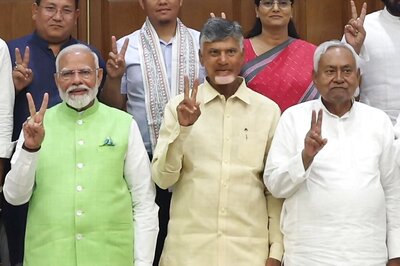
views
Covid protests have gripped several cities of China, including Beijing and Shanghai, spilling over to Hong Kong with even Chinese embassies in global metropolises like London, Paris and Tokyo as well as universities in US and Europe.
While Chinese authorities are clamping down fast on the protests, people’s frustrations with China’s zero-Covid policy have been brewing for some time now.
The wave of protests symbolised by blank A4 sheets and candlelight vigils have been largely peaceful, but Wuhan and Shanghai have witnessed a much more violent turn of events with people knocking over police barriers and many even clashing with security personnel.
The demonstrations that began with rage over harsh zero-Covid policies, are now evolving into a wave of civil disobedience with the Chinese demanding freedom of speech, of assembly, from the dictates of Xi Jinping and the Communist party.
In solidarity with China’s protesters are vigils that have taken place around the globe in countries, including the UK, Australia, Canada, US and Malaysia. Now let’s cut to the chase and answer the most obvious question. Can tensions surrounding China’s zero-Covid policy present an opportunity for India to rejig supply chain models?
Business objectives are not only impacted by China’s lockdowns but also by rising inflation in the wake of Russia’s war with Ukraine.
The recent unrest that took place at the Foxconn plant in China’s Zhengzhou is a stark example of China’s zero-Covid policy gone haywire. Unhappy workers clashed with police at the premium iPhone factory. Viral videos showed people smashing surveillance cameras and windows.
According to a report by news agency Reuters, over 30 per cent of Foxconn’s November production is affected. Especially considering Apple’s Zhengzhou factory is the only one making premium iPhone models, including the iPhone 14 Pro, the violence could well impact Apple shares. Equally noteworthy is the fact that over 20,000 workers, mostly new recruits, have simply left.
Sources quoted in the Reuters report stated that Apple was unlikely to resume full production by the end of this month. Interestingly, Foxconn is the same Taiwanese firm that along with Vedanta announced a $19.5-billion chip factory to build one of the first chip making factories in India. Foxconn already has operations in Tamil Nadu since 2017.
Moreover, in September, amid rising tension between Washington and Beijing, Apple revealed making iPhone 14 in India in a bid to increase its footprint in the South Asian nation. In comments shared with CNN-News18, Apple states, “Apple started manufacturing iPhones in India in 2017 with iPhone SE. Today, Apple manufactures some of its most advanced iPhones in the country, including iPhone SE, iPhone 12, iPhone 13 and now iPhone 14.”
So, should India hope to compete with a global manufacturing giant like China? Let’s do some number crunching based on manufacturing data from 2021 shared by The World Bank.
While the total global manufacturing value added in dollars was $16.35 trillion, China’s contribution was the highest at $4.87trillion followed by US at $2.34 trillion, Japan at $995.31 billion, Germany at $772.25 billion and India at $446.5 billion.
In fact, as per data released by the UN Statistics Division, in 2018, China was credited for 30 per cent of the world’s manufacturing. But in 2019, Covid struck and, even though the world has learnt to live with it, China’s Jinping-led government is too scared to test the waters by loosening measures.
That leaves the world with other top global manufacturing alternatives – Japan, Vietnam, India, Bangladesh, Malaysia, Indonesia, Thailand and Singapore. Low-cost manufacturing played a massive role in making China the second largest economy in the world by 2010. This stands out, especially when compared to 1980 when China was just the ninth largest economy.
The Prime Minister Narendra Modi-led government has been pushing packages to attract investors to the country and yet India is lagging behind. So much so, the prime minister’s ‘Make In India’ aims to do exactly that – bring global manufacturing to India. But India must further develop its infrastructure, education and workforce.
The proof is in the pudding. While Apple may have moved some of its manufacturing to India, Google is betting its units on Vietnam while Microsoft is already making gaming consoles over there. Still, Amazon is building Fire TV devices in India.
India’s prospects are still not as exciting. According to a study conducted by Nomura, 56 companies relocated production away from China between April 2018 and August 2019. This data throws up some rather dismal details – while two companies relocated to Indonesia, eleven went to Taiwan, eight to Thailand, 26 to Vietnam and only three came to India.
And when we specifically speak of smartphones, Indian manufacturers are resource-constrained with the majority of the components being imported. In fact, data provided by Counterpoint research suggests that four-fifths of the total imported components still come from China.
The violence at Foxconn shares parallels with the Xinjiang cotton boycott, which also presented a golden opportunity for India’s global exports of cotton. India is still unable to fill that gap, which is already capitalised by Bangladesh, Indonesia, Vietnam and the Philippines.
The UK’s newly appointed prime minister, Rishi Sunak, has already announced that his country’s “golden era” of relations with China is over. He has vowed to review the UK’s economic ties with Beijing, so much so that he referred to the country as a “systemic challenge”.
The timing of such an announcement, that too in Sunak’s first foreign policy speech, is highly significant keeping in mind that there are renewed hopes for the free trade agreement between India and UK. Should India not milk the moment, one that is ripe with opportunity?
To end on a more optimistic note, let me refer to a recent report by S&P Global, which states that India is expected to become the world’s third largest economy beating Japan and Germany. It states that India’s real gross domestic product is expected to grow at a pace of 6.3 per cent annually between FY 2021-30.
Boosting domestic manufacturing and deepening trade ties with global economies are two crucial factors quoted by S&P Global, which can help expedite India’s economic growth. And yet, much awaits to be done for India to become a preferred destination.
Read all the Latest Opinions here




















Comments
0 comment